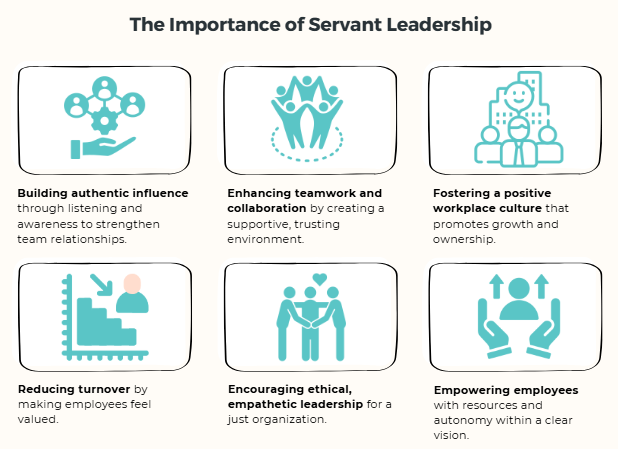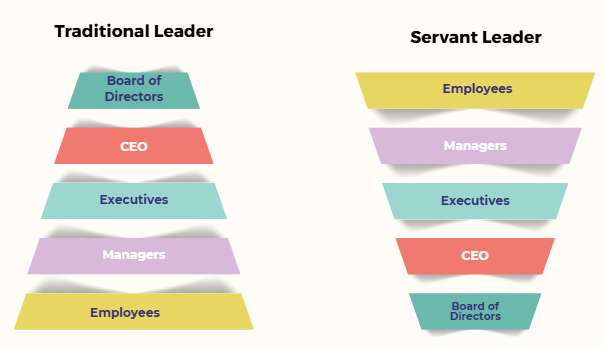Servant Leadership
Servant leadership is highly relevant and effective in modern organizations, especially with the growing prevalence of remote and hybrid work. Leaders who prioritize empathy, trust, and support, rather than control or micromanagement, create a positive environment where employees feel valued. By actively listening, removing obstacles, and focusing on the growth of their team members, servant leaders foster a culture of psychological safety, motivation, and innovation. This results in higher engagement, improved retention, stronger collaboration, and greater organizational resilience in the face of ongoing change.
Today’s employees look for more than just a paycheck—they seek meaningful work, connection, and recognition. Servant leadership addresses these needs by putting people first, helping organizations attract and retain top talent while enhancing creativity and performance. It also aligns with the growing emphasis on ethical and sustainable business practices, supporting long-term success rather than short-term gains.
1. What is Servant Leadership?
The concept of servant leadership was formally introduced in 1970 by Robert K. Greenleaf, a former AT&T executive, in his essay “The Servant as Leader.” Greenleaf proposed that true leadership begins with serving others, prioritizing their growth and well-being over traditional notions of authority and control. His idea was inspired by Hermann Hesse’s novella Journey to the East, which features a servant named Leo whose quiet support ultimately guides a group through challenges. Greenleaf also drew from biblical teachings, such as Jesus’ message that greatness comes through serving others (Mark 10:42–45), and from historical examples like King Frederick II of Prussia, who famously called himself “the first servant of the state.” While Greenleaf coined and popularized the term in the 20th century, the principle of leading through service has deep roots in religious, philosophical, and cultural traditions throughout history.
2. Why Servant Leadership is Important?
The importance of servant leadership lies in its focus on putting others first—prioritizing the needs, growth, and well-being of team members and the organization over the leader’s own interests. This mindset builds authentic relationships, fosters trust and collaboration, and creates a positive work environment that leads to higher employee engagement, lower turnover, and greater organizational agility and performance.
Key benefits of servant leadership include:
Building authentic influence through persuasion, awareness, and listening, which helps leaders maintain strong, culturally aligned relationships with their teams.
Enhancing teamwork and collaboration by fostering a supportive and trusting atmosphere where employees feel empowered and valued.
Creating a positive workplace culture that encourages growth, development, and ownership among team members, helping them perform at their highest potential.
Reducing employee turnover as employees are more likely to stay with organizations where they feel supported and heard.
Promoting ethical and empathetic leadership that is grounded in serving a greater good, which can lead to more just and caring organizations and communities.
Empowering employees by providing them with the necessary resources, support, and autonomy to contribute meaningfully while the leader sets a strategic vision and framework.
3. Differences between Traditional Leader and Servant Leader
Traditional leaders focus on directing and controlling to achieve business goals, emphasizing authority and hierarchy. Their priority is organizational success often through top-down decision-making.
In contrast, servant leaders prioritize serving their people first, focusing on their development, well-being, and empowerment. They lead by building trust, fostering collaboration, and facilitating collective decision-making. Servant leadership shifts the power dynamic from control to service, aiming to create more motivated, engaged, and resilient teams.
The key differences between traditional leadership and servant leadership revolve around their focus, approach, and underlying philosophy:
| Aspect | Traditional Leadership | Servant Leadership |
|---|---|---|
| Focus | Achieving organizational goals and results | Serving and empowering people |
| Approach | Top-down, hierarchical authority | Bottom-up, collaborative and inclusive |
| Leader’s Role | Directive, controlling, making decisions for the team | Supportive, removing obstacles, facilitating growth |
| Power Dynamics | Leader holds authority and control | Leader shares power, leads by serving others |
| Motivation Style | Uses rewards, punishments, and command | Inspires through empathy, listening, and trust |
| Decision-Making | Centralized, leader-driven | Democratic, involving the team |
| Focus on People | Often secondary to organizational objectives | Primary, prioritizing team members’ growth and well-being |
| Communication Style | One-way, from leader to followers | Two-way, active listening and feedback |
| Organizational Culture | Emphasizes efficiency and productivity | Emphasizes trust, collaboration, and ethical values |
4. Characteristics of a Servant Leader
Servant leaders prioritize the needs of their team members and focus on helping them grow and develop, rather than solely focusing on their own authority or goals. They lead by serving, fostering a sense of community and shared purpose. Key characteristics include:
Listening – Servant leaders actively listen to understand others completely, including the unsaid, which helps clarify the group's will and build trust.
Empathy – They deeply understand and accept others as they are, caring about their feelings and perspectives, and treat people with kindness and respect.
Healing – Servant leaders support emotional and spiritual well-being, helping individuals overcome difficulties and promoting wholeness.
Awareness – They possess strong self-awareness of strengths, weaknesses, values, and biases, helping them make fair decisions and better understand others.
Persuasion – Rather than relying on authority, servant leaders use influence and persuasion to guide others and resolve conflicts.
Conceptualization – They think beyond day-to-day realities and help envision long-term goals, encouraging innovation and improvement.
Foresight – Servant leaders anticipate future outcomes and learn from past experiences to guide their team wisely.
Stewardship – They take responsibility for their role, protect trust, and lead by example with integrity.
Commitment to the Growth of People – Servant leaders are invested in the personal and professional development of their team members.
Building Community – They foster collaboration and create a sense of belonging within teams and organizations.
5. Conclusion
Companies suitable for servant leadership tend to be those that prioritize long-term employee well-being, collaboration, ethical culture, and community values over short-term profits or strict hierarchical control. Servant leadership fits well in organizations that want to empower employees, foster trust, and build strong, inclusive cultures focused on serving all stakeholders.



